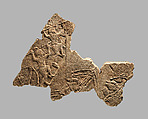Relief fragment: siege of a city by Assyrian troops
Not on view
This relief fragment depicts part of an Assyrian assault on a fortified city. Two spearmen with crested helmets and round shields climb a ladder at the city wall, while beneath them ranks of Assyrian archers fire upward toward defenders (not preserved in this fragment). The Assyrian army, the great military power of its time in the Near East, was extremely effective in siege warfare and the taking of cities, and multiple depictions of sieges in reliefs such as this capture many of the technologies and tactics they employed. As well as the use of specialist ladder and spear teams with covering fire as depicted here, Assyrian reliefs depict examples of battering rams and siege engines, the undermining of walls, and even actions taken by the defenders such as pouring hot water or oil or attempting to sabotage siege engines.
Drawings from the nineteenth century excavations at Nineveh indicate the original location of this fragment in the Southwest Palace, Sennacherib’s (r. 704–681 B.C.) "Palace Without Rival," where it formed part of a military campaign taking place in a wooded and hilly country whose depiction probably filled the entire room. As was typical, the reliefs showed not only the sieges and military actions themselves but also their aftermath, with the taking of prisoners, livestock, and booty, and the counting of enemy soldiers’ heads – a common ancient approach to recording the casualties of battle. The reliefs are those of Sennacherib, the original builder of the palace, and are thought to depict events from his second major military campaign as king, in 702 B.C., which texts describe as taking place against multiple enemies in the central Zagros Mountains in western Iran. This area, and specifically the route through the mountains, was strategically important to the Assyrians as it controlled access to a key trade route east – what in later times would become known as the Great Khorasan Road.
Due to rights restrictions, this image cannot be enlarged, viewed at full screen, or downloaded.

